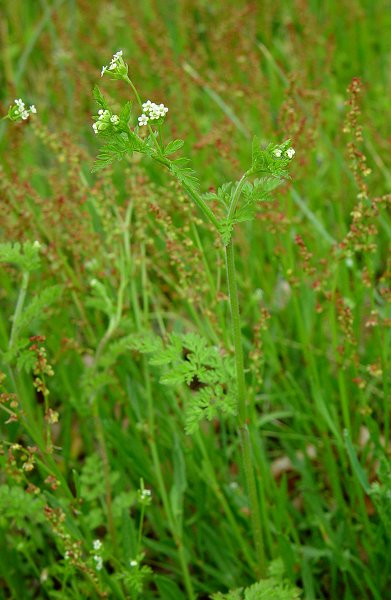Chaerophyllum tainturieri Hook.
Wild Chervil

Native
CC = 3
CW = 0
MOC = 52
© DETenaglia
Chaerophyllum tainturieri Hook.Wild Chervil | |
 |
Native CC = 3 CW = 0 MOC = 52 |
© DETenaglia |
|
Family - Apiaceae Habit - Taprooted annual forb. Stems - Spreading to loosely ascending, to 60 cm, multiple from the base, branching, angled, moderately to densely hairy toward the base, sparsely to moderately so toward the tip, slightly carroty scent.
Leaves - Alternate, to 12 cm long, typically sessile or with a short flattened sheathing petiole, bipinnately divided, glabrous or the underside moderately hairy. Petioles sheathing, adaxially grooved. Leaflets deeply lobed to pinnatifid. Ultimate divisions 1-6 mm long, 1-3 mm wide, oblong-elliptic, entire, rounded to subacute at apex, often with a reddish margin and a minute orange spot near the tip (use a lens to see). Leaves green above and light green below.
Inflorescence - Terminal and axillary, compound or sometimes simple (1-rayed) umbels, sessile to short- or long-stalked. Rays 0.3-1.5 cm long at flowering, elongating to 7.0 cm at fruiting, sparsely to moderately short-hairy. Rays typically 3 per inflorescence. Umbellets subtended by 4-6 ovate to oblong bractlets, these mostly longer than the flowering pedicels. Pedicels 2-3 mm long in flower, to 10 mm long in fruit, glabrous, flared at the tip. Flowers - 2-15 per umbellet. Petals 5, white, glabrous, to 1 mm, elliptic or orbicular, acute, spreading. Stamens 5, spreading, alternating with the petals. Filaments glabrous, white, 0.8 mm long. Anthers yellow, 0.3 mm long. Styles 2, expanded at base into conic stylopodia. Stigma translucent. Ovary glabrous, green, inferior, 1-1.1 mm long in flower, 2-carpellate. Calyx tube green, glabrous, 1.5-2 mm long in flower, quickly expanding in fruit. Calyx lobes absent.
Fruits - Schizocarps 4-8 mm long, glabrous, elliptic-oblong, with one seed per carpel.
Flowering - March - June. Habitat - Rocky open glades, prairies, forests, fields, roadsides, open disturbed areas. Origin - Native to the U.S. Lookalikes - Chaerophyllum procumbens. Vegetatively the plant resembles several other unrelated species (Daucus carota, Cystopteris spp., and others) and can be difficult to distinguish reliably. Other info. - This little species can be found mostly in the southern half of Missouri, and also occurs in most of the southeastern quadrant of the continental U.S. The plant is somewhat weedy in habit and is often overlooked because of this. It can be differentiated from the very similar C. procumbens by the fruit stalks, which are flared near the tips instead of being of constant thickness. C. tainturieri is also hairier toward the base, though degrees of pubescence can be wildly variable. These difference are subtle and some specimens can be difficult to assign. Photographs taken in Brown Summit, NC., 4-20-03 (DETenaglia), and near Labadie, Franklin County, MO, 5-25-2021 (SRTurner). |